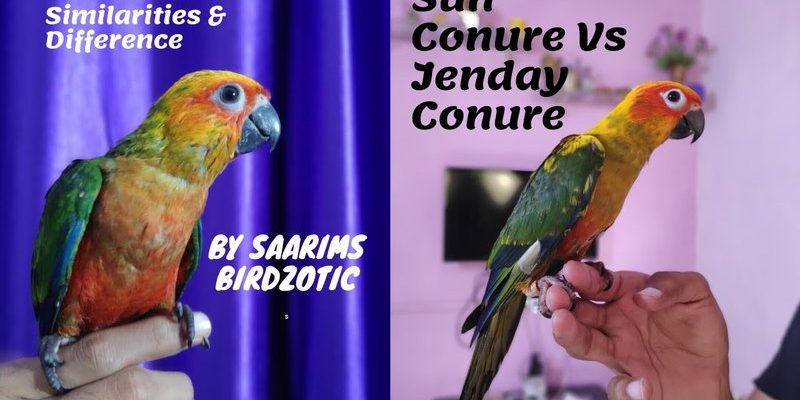
So, let’s sit down with a cup of coffee and break down the differences between conures and other similar bird species. This way, you can understand which feathered friend would fit best in your life. Whether you’re a first-time bird owner or someone looking to add to your flock, understanding these differences can help you make a more informed decision.
What Exactly Are Conures?
Conures belong to a family of small to medium-sized parrots, and they’re known for their bright plumage and outgoing personalities. Picture a cheerful little bird with vibrant feathers—often shades of green, yellow, and orange—perched on your shoulder, chattering away like it’s the life of the party!
There are many different species of conures, each with its own traits. The sun conure is particularly popular due to its stunning orange-yellow coloration, while the green-cheeked conure is loved for its gentle demeanor and smaller size. Conures are social creatures that thrive on interaction, and they’re often seen as playful companions. Whether it’s mimicking sounds, exploring new toys, or showing off their acrobatic skills, they’re sure to bring joy to any household.
Conures vs. Parrots: What’s the Difference?
You might be wondering how conures differ from other parrots. While all conures are technically parrots, not all parrots are conures. Parrots encompass a broad range of species—from larger macaws to smaller parakeets.
Size and Lifespan: Conures typically range from 10 to 20 inches in length, depending on the species. In comparison, larger parrots like macaws can reach up to 40 inches! Also, the lifespan of a conure is generally around 20-30 years, which is shorter than that of larger parrots, like the African Grey, which can live up to 60 years or more.
Temperament: In terms of temperament, conures are often more playful and less demanding than larger parrots. They have a reputation for being more social and easier to bond with, making them great for families or first-time bird owners. On the other hand, some larger parrots may require more space, time, and attention, making them more suitable for experienced bird keepers.
Conures vs. Lovebirds: A Quick Comparison
Next up on our bird comparison list are lovebirds. These charming little parrots are known for their affectionate nature, often forming strong bonds with their partners—whether that be a human or another lovebird.
Social Behavior: While both conures and lovebirds thrive on social interaction, lovebirds tend to be a bit more reserved. They are known for forming strong pair bonds, which means they might not always seek attention from their human owners like conures do. If you enjoy an active, playful bird that loves to explore and entertain, a conure might be your best bet.
Size and Care: Lovebirds are generally smaller than conures, measuring around 5 to 7 inches in length. This can make a difference when it comes to space and care. For smaller living spaces, lovebirds might fit in better, while conures need a bit more room to flap their wings and roam around.
Comparing Conures and Budgies
Budgies, or parakeets, are another popular choice for pet owners, but how do they stack up against our feathered friends, the conures?
Cost and Care: One big difference is the cost of care. Budgies are generally less expensive to purchase and maintain. This affordability can make them an attractive option for someone new to bird ownership. However, don’t let the lower cost fool you—budgies have their quirks just like conures. They are very social and can also be great companions, but they might require different types of interaction.
Vocalization: In terms of vocalization, conures are known for being particularly loud and boisterous, often expressing themselves through a range of vocalizations. Budgies, on the other hand, can be chatty but typically have softer voices. If noise is a concern in your living situation, this could be an important factor to consider.
The Unique Traits of Conures
One of the standout features of conures is their ability to mimic sounds and even speech. They are often considered some of the best talkers among the smaller parrot species. If you enjoy the idea of having a feathery companion that can chatter away with you, conures might be the perfect fit!
Playfulness and Activity Level: These birds love to be active. From climbing to swinging, they need plenty of toys and opportunities to play. If you have the time to dedicate to play sessions throughout the day, you’ll likely find a conure to be an incredibly rewarding pet. They can often keep themselves entertained, but their playful nature means they also love engaging with you.
Dietary Needs: When it comes to diet, conures require a balanced mix of seeds, pellets, fresh fruits, and veggies. They can be a bit picky eaters at times, so ensuring they have a varied diet is key. Other similar species, like lovebirds and budgies, have different dietary needs, which might make feeding them a bit easier or harder, depending on your preferences.
Deciding on Your New Feathered Friend
Choosing between a conure and another bird species ultimately boils down to your lifestyle and what you’re looking for in a pet. If you want a vibrant, social bird that loves to engage with you and explore its environment, a conure could be your best option.
On the other hand, if you prefer a smaller bird or one that requires less interaction, a lovebird or budgie might suit your needs better. Consider factors like space, budget, and noise level, as these will play significant roles in your decision.
In the end, the differences between conures and similar bird species can help you make a decision that aligns with your lifestyle. Each bird has its unique personality traits and care requirements, and understanding these can lead you to a happy match.
So, whether you’re leaning towards a lively conure or another bird type, take the time to consider what would work best for you. Remember, each bird is a delight in its own right, bringing love and laughter into your home. Happy bird-choosing!

